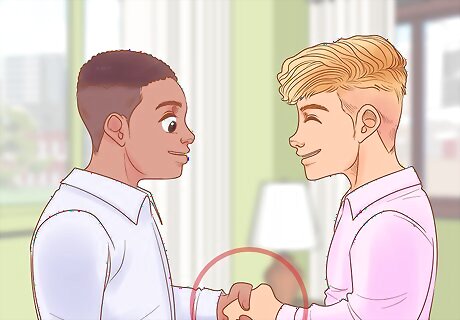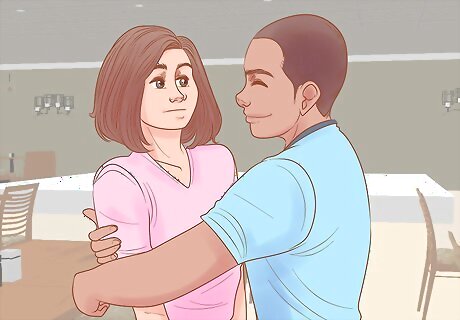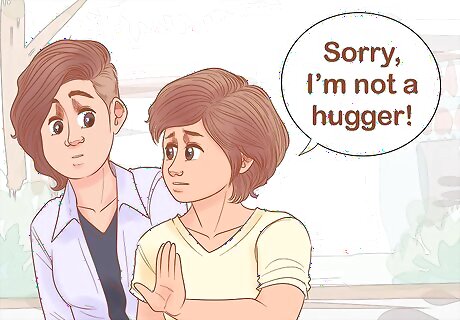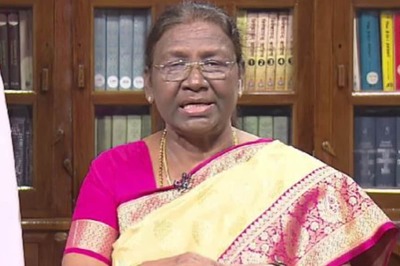
views
Deflecting Hugs

Step backwards if you sense that a hug is approaching. This will create a wider space between you and the potential hugger. It will hopefully indicate to them that a hug wouldn’t be appropriate in the situation. Creating a bigger space between you and the hugger will also give them a physical sense of your personal space, which they will learn not to cross unless you invite them.

Offer a handshake and a smile as a polite alternative. Use this method as your go-to hug avoidance strategy in the workplace. When you are a more comfortable distance away from the potential hugger, make it clear that despite not being open for a hug, that you do want to engage in a greeting. Extend your hand forward and smile in a friendly manner. A handshake will be accepted as an alternative greeting in most instances, and this should help to make it clear for future social interactions with this person that hugs aren’t the way to go. Initiating the handshake as soon as possible will help the other person to follow your lead, even if they were planning on hugging you. You could also offer another greeting, like an elbow bump or a wave.

Turn a shoulder towards the hugger to deflect a hug. Moving your shoulder towards the hugger removes your body from the hugging zone. You can also take a small step backward with one foot, which further turns your body to the side. Having your body side-on rather than facing forward provides a much smaller target for a potential hug, which makes it less likely to happen.

Clasp the other person’s hand if they reach in for a hug. Wrap your hands around their hand or arm if necessary, squeeze gently, and make eye contact. Shake their hand warmly for a few seconds before letting go. If it’s a casual situation, try going in for a high five, or a fist bump, instead of clasping the other person’s hand. Cutting the hugger off before they reach you is an effective, last-minute solution for avoiding an upcoming hug. Don’t feel guilty or ashamed about cutting off a hug before it even starts. Cover it with a friendly greeting, such as “It’s so nice to see you!"
Getting Out of Unwanted Hugs

Keep your hands by your sides if the person hugs you anyway. Reciprocation is the key to a successful hug, so you not hugging back should get the message across to the other person. Make sure that your arms sit straight by your sides, and don’t give in at any point. An unreciprocated hug will be an awkward hug. This means that despite the hugger not picking up on your social cues the first time around, they will hopefully remember how awkward the hug was and greet you differently in the future.

Break the hug off quickly if not hugging back makes you uncomfortable. Try giving the hugger a quick shoulder pat and then breaking the hug off quickly. This should get your message across clearly.

Remind the person that you don’t like hugs. If the hug has gone ahead, politely but firmly remind the hugger that you would prefer not to hug. Step back from the hug and say, “Sorry, I’m not a hugger!” If the person tries to hug you again in the future, you can use a more drastic reminder. Saying “Stop!” loudly, and putting your arms in front of your chest is usually enough.
Politely Declining Hugs

Make it clear that you don’t like hugs if you are joining a new workplace. As you get introduced to your new group of colleagues, be upfront yet friendly about how you aren’t a huggy person. Offer everyone an alternative friendly greeting, such as a high five, fist bump, wave, or handshake depending on the formality of the situation. “I’m not a hugger, I’m a handshake sort of person” will work well in most situations.

Talk about your feelings if somebody doesn’t understand. If an acquaintance or coworker doesn’t pick up on your body language, use your words to let them know how you are feeling. Pull them aside, be polite and friendly, and say something along the lines of “You might have noticed that I’m not much of a hugger, and I feel more comfortable with handshakes.” Your honesty in these situations may come across just as well as a warmly reciprocated hug!

Avoid pressuring your kids to hug when they don’t want to. Although you might be afraid that it will come across as rude, don’t make your kids hug or kiss family members when they clearly feel uncomfortable. Compromise with them and let them know that they don’t have to hug a relative if they don’t to, but that you do expect them to make eye contact, and give a smile, high five, or wave instead. Children who don’t want to be hugged aren’t trying to be rude. They may just be shy, uncomfortable, or still learning about social situations. Either way, forcing them to hug when they don’t want to will not create a positive situation for them.
















Comments
0 comment